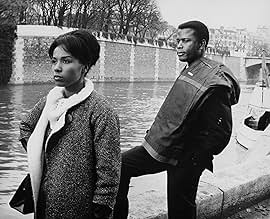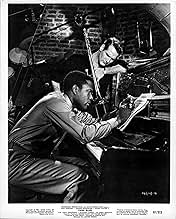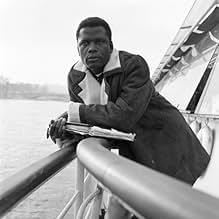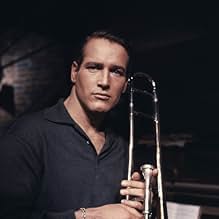IMDb RATING
6.7/10
4.4K
YOUR RATING
During the 1960s, two American expatriate jazz musicians living in Paris meet and fall in love with two American tourist girls.During the 1960s, two American expatriate jazz musicians living in Paris meet and fall in love with two American tourist girls.During the 1960s, two American expatriate jazz musicians living in Paris meet and fall in love with two American tourist girls.
- Nominated for 1 Oscar
- 2 nominations total
Guy Pedersen
- Bass Player
- (as Guy Pederson)
Roger Blin
- Guitarist Fausto the Moor
- (uncredited)
Charles Bouillaud
- Luggage Carrier in Train
- (uncredited)
Michel Dacquin
- Guest at Devigne's Party
- (uncredited)
Hélène Dieudonné
- The Pusher
- (uncredited)
Michel Garland
- Club 33 Customer
- (uncredited)
Featured reviews
When the story begins, Ram (Paul Newman) and Eddie (Sidney Poitier) are American musicians who have been living in Paris for some time. They love jazz and spend their evenings performing in various clubs. However, their bohemian lifestyle is about to be challenged in the form of two ladies who are traveling together (Joanne Woodward and Diahann Carroll). When love is in the air, there are problems--can such a lifestyle work with wives AND would these men be willing to return home to the States if need be?
This is a film I really enjoyed for a couple reasons. First, the acting was terrific and the characterizations were very nice. Second, the story is unusual. However, some of it being unusual is because the movie leaves the viewer wondering what will happen next...will they have a happy ending or not? Well, the film doesn't make this clear...which didn't bother me. Worth seeing.
This is a film I really enjoyed for a couple reasons. First, the acting was terrific and the characterizations were very nice. Second, the story is unusual. However, some of it being unusual is because the movie leaves the viewer wondering what will happen next...will they have a happy ending or not? Well, the film doesn't make this clear...which didn't bother me. Worth seeing.
this movie has been mischaracterized as a fluffy love story, it is not. this film examines racial equality and the differences between France and the us in accepting people of color as more than "help" or as something to fear. this film also touches on the popularity of jazz music, and showcases authentic early jazz as well as painting a picture of the hip jazz subculture, including smoky clubs, late nights and loose women. the film also shows the journey of young musicians trying to find their style and find a place for themselves as jazz composers- not just as musicians. finally, this movie does reflect aspects of a love story- but in examining the film on a deeper level one finds that there really is no love, rather it is a commentary on disconnected, self-indulgent lust. finally - Louis Armstrong appeared and played in the movie- Does it get any better?
10rps-2
For starters, this is one of those rare movies that would not have been as good if it had been shot in colour. B&W somehow fits the mood, the story and the setting. Yet it's not really a sad or dark story. As in many older B&W films, the lighting is magnificent with highlights and shadows and textures that simply aren't workable in colour. The performances are universally superb. The script is free of the usual clichés. And the music is great. (How could you possibly make a bad movie with the likes of Louis Armstrong, Paul Newman, Joanne Woodward, Sidney Poitier and Diane Carrol?) Nor, in that era (1961), did Hollywood zoom in and linger obsessively on sexual acrobatics. This is a mature, sexy film without any graphic sex. Those were the rules back then and this film is the better for them. A thoroughly enjoyable movie with a great cast that has stood the test of a half century very well indeed.
The American in Paris theme has been done very often in American cinema. The tradition is huge splashy technicolor with Gene Kelly, Fred Astaire, Jane Powell, Audrey Hepburn cavorting around the well known streets and landmarks. Those are nice films, but that ain't what you get here.
No Louvre, no Arc de Triomphe, no Eiffel Tower, a brief shot of Notre Dame from a distance; that's about it from the well known Paris. The Paris we see here in this black and white film is of the jazz clubs of the Left Bank where two expatriate musicians, Paul Newman and Sidney Poitier, eke out a living doing what they love.
Newman has ambitions though, he'd like to be a serious composer not a trombonist all his life. Poitier has come to Paris for reasons of the race problems in the USA.
Into their lives two American tourists come, Joanne Woodward and Diahann Carroll. A couple of dual romances commence.
Carroll and Poitier have a spirited debate over civil rights. The movement is getting into high gear in America and Carroll wants him to return and be part of it. No thanks, says Poitier, he just wants to do his jazz thing where his skin color isn't anyone's problem least of all his own.
Interestingly Carroll was doing a kind of warm up for another part of a black woman in Paris on Broadway the following year in Richard Rodgers, No Strings. In that play she falls for an expatriate writer played by Richard Kiley. An interracial romance, one of the first shown on the Broadway stage, still a lot of the same issues were in that show.
Paris Blues is a different slice of Parisian life for an American film to explore. All four leads do just fine, though the film probably doesn't rank in the top work of any of them.
Lots of jazz music for the aficionado. And of course the presence of the incomparable Louis Armstrong. The highlight of the film is the jam session with those two ersatz musicians Newman and Poitier.
The way Satchmo is received by the public only proves the truth of that line he sang in High Society about the way the French love American jazz.
No Louvre, no Arc de Triomphe, no Eiffel Tower, a brief shot of Notre Dame from a distance; that's about it from the well known Paris. The Paris we see here in this black and white film is of the jazz clubs of the Left Bank where two expatriate musicians, Paul Newman and Sidney Poitier, eke out a living doing what they love.
Newman has ambitions though, he'd like to be a serious composer not a trombonist all his life. Poitier has come to Paris for reasons of the race problems in the USA.
Into their lives two American tourists come, Joanne Woodward and Diahann Carroll. A couple of dual romances commence.
Carroll and Poitier have a spirited debate over civil rights. The movement is getting into high gear in America and Carroll wants him to return and be part of it. No thanks, says Poitier, he just wants to do his jazz thing where his skin color isn't anyone's problem least of all his own.
Interestingly Carroll was doing a kind of warm up for another part of a black woman in Paris on Broadway the following year in Richard Rodgers, No Strings. In that play she falls for an expatriate writer played by Richard Kiley. An interracial romance, one of the first shown on the Broadway stage, still a lot of the same issues were in that show.
Paris Blues is a different slice of Parisian life for an American film to explore. All four leads do just fine, though the film probably doesn't rank in the top work of any of them.
Lots of jazz music for the aficionado. And of course the presence of the incomparable Louis Armstrong. The highlight of the film is the jam session with those two ersatz musicians Newman and Poitier.
The way Satchmo is received by the public only proves the truth of that line he sang in High Society about the way the French love American jazz.
Within 2 years of "Paris Blues" being released the US involvement in Vietnam began to sour the relationship between America and la rive gauche. French intellectuals affected to disdain the United States and all its works;one of the few aspects of Americana that were permitted to be still admired was jazz music. Even so the myth of the American jazz musician as a god-like figure had faded by the mid sixties.Giants like Louis Armstrong and Duke Ellington were still revered but the journeymen jazzers like Ram Bowen(Newman)no longer filled the clubs just because they were American. The Indian Summer of America's honeymoon with Europe peaked with "Paris Blues".
Beautifully shot in black and white in the quintessentially Parisian parts of the city where the 2 pairs of lovers could stroll hand in hand photogenically it was a love letter to the arondissements beloved of Scott Fitzgerald,Hemingway and Gertrude Stein 30 years after the affair had ended.
Paul Newman was never more charming,Sidney Poitier never more cool and self-effacing;their pairing considered quite daring at the time coming just a few years after the ground-breaking "The Defiant Ones". Duke Ellington wrote the score and his "Mood Indigo" is beautifully played by Murray McCeachern.Louis Armstrong plays himself - why his character is named Wild Man Moore one can only speculate.
I saw "Paris Blues" when I was 20 years old and my love affair with jazz was a its height. Looking at it now it doesn't seem all that special,the characters and situations have all become clichés;but perhaps that's a bit like saying "Hamlet"'s a good play but it's full of quotations.
Beautifully shot in black and white in the quintessentially Parisian parts of the city where the 2 pairs of lovers could stroll hand in hand photogenically it was a love letter to the arondissements beloved of Scott Fitzgerald,Hemingway and Gertrude Stein 30 years after the affair had ended.
Paul Newman was never more charming,Sidney Poitier never more cool and self-effacing;their pairing considered quite daring at the time coming just a few years after the ground-breaking "The Defiant Ones". Duke Ellington wrote the score and his "Mood Indigo" is beautifully played by Murray McCeachern.Louis Armstrong plays himself - why his character is named Wild Man Moore one can only speculate.
I saw "Paris Blues" when I was 20 years old and my love affair with jazz was a its height. Looking at it now it doesn't seem all that special,the characters and situations have all become clichés;but perhaps that's a bit like saying "Hamlet"'s a good play but it's full of quotations.
Did you know
- TriviaPaul Newman was coached in playing the trombone by Billy Byers, while the playing for Newman on the soundtrack was done by Murray McEachern. Sidney Poitier's tenor sax playing was done by Paul Gonsalves. The soundtrack was recorded May 1-3, 1961 at Reeves Sound Studios in New York City.
- GoofsSome may believe that the mouthpiece ligature on the tenor saxophone that Eddie Cook (Sidney Poitier) plays is upside down. However, in the first scene when the band is playing, it can be seen that the thumbscrew that adjusts the ligature is on the bottom, where it normally would be. It is, therefore, not upside down.
- Crazy credits"Introducing" Serge Reggiani, who by 1961 had been in French films for 20 years and a star at least throughout the 1950s.
- ConnectionsFeatured in A Century of Black Cinema (2003)
- SoundtracksTake The 'A' Train
(uncredited)
Music by Billy Strayhorn
Recorded at Reeves Sound Studios, New York on May 2 & 3, 1961.
Label - United Artists
- How long is Paris Blues?Powered by Alexa
Details
- Release date
- Country of origin
- Languages
- Also known as
- París vive de noche
- Filming locations
- Production companies
- See more company credits at IMDbPro
Box office
- Gross US & Canada
- $1,300,000
- Runtime
- 1h 38m(98 min)
- Color
- Aspect ratio
- 1:66
Contribute to this page
Suggest an edit or add missing content





















